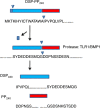The functional significance of dentin sialoprotein-phosphophoryn and dentin sialoprotein
- PMID: 30393383
- PMCID: PMC6215839
- DOI: 10.1038/s41368-018-0035-9
The functional significance of dentin sialoprotein-phosphophoryn and dentin sialoprotein
Abstract
Phosphophoryn (PP) and dentin sialoprotein (DSP) are the most dominant non-collagenous proteins in dentin. PP is an extremely acidic protein that can function as a mineral nucleator for dentin mineralization. DSP was first identified in 1981, yet its functional significance is still controversial. Historically, these two proteins were considered to be independently synthesized and secreted by dental pulp cells into the developing dentin matrix. However, with the identification of the DSP coding sequence in 1994, followed 2 years later by the finding that the PP coding sequence was located immediately downstream from the DSP sequence, it became immediately clear that DSP and PP proteins were derived from a single DSP-PP (i.e., dentin sialophosphoprotein, DSPP) transcript. Since DSPP cDNA became available, tremendous progress has been made in studying DSP-PP mRNA distribution and DSP generation from the DSP-PP precursor protein at specific cleavage sites by protease tolloid-related-1 (TLR1) or bone morphogenetic protein 1 (BMP1). The functions of DSP-PP and DSP were investigated via DSP-PP knockout (KO) and DSP knockin in DSP-PP KO mice. In addition, a number of in vitro studies aimed to elucidate DSPP and DSP function in dental pulp cells.
Conflict of interest statement
There is no conflict of interests.
Figures

 ;
;  Represents DSP exons;
Represents DSP exons;  Represents PP exon;
Represents PP exon;  Represents the 3′ noncoding sequence;
Represents the 3′ noncoding sequence;  Represents the DSP-PP promoter region;
Represents the DSP-PP promoter region;  Represents the transcription start site;
Represents the transcription start site;  Represents the stop codon
Represents the stop codon



Similar articles
-
DSP-PP precursor protein cleavage by tolloid-related-1 protein and by bone morphogenetic protein-1.PLoS One. 2012;7(7):e41110. doi: 10.1371/journal.pone.0041110. Epub 2012 Jul 17. PLoS One. 2012. PMID: 22815932 Free PMC article.
-
Expression of mineralized tissue associated proteins: dentin sialoprotein and phosphophoryn in rodent hair follicles.J Dermatol Sci. 2011 Nov;64(2):92-8. doi: 10.1016/j.jdermsci.2011.08.009. Epub 2011 Aug 27. J Dermatol Sci. 2011. PMID: 21908176 Free PMC article.
-
DSPP dosage affects tooth development and dentin mineralization.PLoS One. 2021 May 26;16(5):e0250429. doi: 10.1371/journal.pone.0250429. eCollection 2021. PLoS One. 2021. PMID: 34038418 Free PMC article.
-
The nature and functional significance of dentin extracellular matrix proteins.Int J Dev Biol. 1995 Feb;39(1):169-79. Int J Dev Biol. 1995. PMID: 7626404 Review.
-
Dentin matrix proteins and dentinogenesis.Connect Tissue Res. 1995;33(1-3):59-65. doi: 10.3109/03008209509016983. Connect Tissue Res. 1995. PMID: 7554963 Review.
Cited by
-
Dentin Sialoprotein/Phosphophoryn (DSP/PP) as Bio-Inductive Materials for Direct Pulp Capping.Polymers (Basel). 2022 Sep 3;14(17):3656. doi: 10.3390/polym14173656. Polymers (Basel). 2022. PMID: 36080731 Free PMC article.
-
Dentin Phosphophoryn-Derived Peptide Promotes Odontoblast Differentiation In Vitro and Dentin Regeneration In Vivo.Materials (Basel). 2021 Feb 12;14(4):874. doi: 10.3390/ma14040874. Materials (Basel). 2021. PMID: 33673176 Free PMC article.
-
Retinoic Acid Signal Negatively Regulates Osteo/Odontogenic Differentiation of Dental Pulp Stem Cells.Stem Cells Int. 2020 Jun 27;2020:5891783. doi: 10.1155/2020/5891783. eCollection 2020. Stem Cells Int. 2020. PMID: 32676119 Free PMC article.
-
NBCe1 Regulates Odontogenic Differentiation of Human Dental Pulp Stem Cells via NF-κB.Int J Stem Cells. 2022 Nov 30;15(4):384-394. doi: 10.15283/ijsc21240. Epub 2022 Jun 30. Int J Stem Cells. 2022. PMID: 35769055 Free PMC article.
-
p75NTR promotes tooth rhythmic mineralization via upregulation of BMAL1/CLOCK.Front Cell Dev Biol. 2023 Nov 7;11:1283878. doi: 10.3389/fcell.2023.1283878. eCollection 2023. Front Cell Dev Biol. 2023. PMID: 38020910 Free PMC article.
References
-
- Linde A, Bhown M, Butler WT. Noncollagenous proteins of dentin. A re-examination of proteins from rat incisor dentin utilizing techniques to avoid artifacts. J. Biol. Chem. 1980;255:5931–5942. - PubMed
-
- Veis, A. in Chemistry and Biology of Mineralized Tissues (ed. Butler, W. T.) 170–184 (EBSCO Media, Birmingham, 1985).
Publication types
MeSH terms
Substances
LinkOut - more resources
Full Text Sources
Research Materials
Miscellaneous

